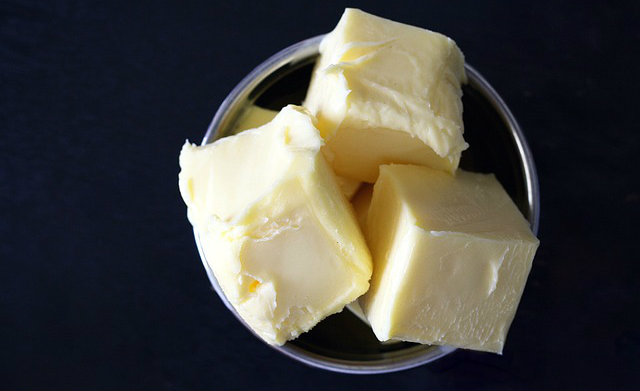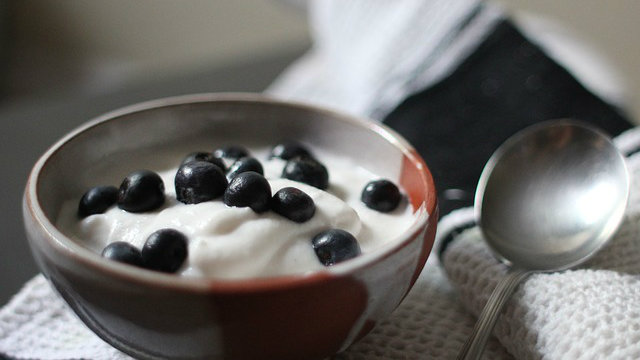
Milk is marketed in a way that makes us all believe it is good for us. It has protein and is the “best” source of calcium, right? This marketing is so powerful that most people will be hard pressed to name any other food that contains moderate to high levels of calcium. I would go as far as to say that we are lead to believe that if we don’t consume dairy, then we will be calcium deficient. Thus, dairy is a staple in the typical Western diet.
In my opinion, this “truth” about dairy products and milk is downright incorrect. Even though dairy does contain calcium, the way your body processes dairy foods may not actually provide you with the benefits that calcium offers.
Here’s an explanation of the real truth about dairy — plus, what you could be eating instead.
Dairy Is an Acid-Forming Food
All the food we eat influences our body’s pH level. Some foods have an alkalizing effect and others are acid forming. Our blood likes to sit at a pH of about 7.4, which is slightly alkaline, and it works very hard to maintain to that level. Unfortunately, the modern American diet includes staple foods that are highly acid forming. Dairy is one of them.
When we consume milk, our body’s response to the increased acid load involves releasing minerals — such as calcium, magnesium, and potassium, which are all necessary for strong bones — into our circulation to bring us back to a pH homeostasis. Those minerals can then be lost, flushed out of our system as waste. For those who live on a modern diet, it has been estimated that the quantity of calcium lost through the urine over time could be as high as almost 480 gm over twenty years — this amounts to almost half the skeletal mass of calcium.1

There has been increased interest in alkaline diets over the past decade since so much more food these days is acid forming. Some advocates suggest an alkaline diet can be helpful in reducing numerous chronic diseases and ailments, including hypertension, diabetes, arthritis, vitamin D deficiency, and low bone density, just to name a few.2
A study of ten different countries, performed by a professor of nutrition at Harvard’s School of Public Health and published in 1986, showed that the consumption of calcium from dairy was the lowest in Hong Kong and Singapore — where they also reported the lowest rate of hip fractures. Conversely, the United States consumed the most amount of calcium from dairy and ranked the highest incidence of hip fractures.3
Drinking loads of milk, even though it does contain calcium, may not be so great on our bones after all. At the very least, we should be looking to other sources to get our daily quota of calcium and not just relying on dairy. Instead, try adding more kale and fish that includes the bones, such as sardines and canned salmon.

Dairy Is Difficult for Many to Digest
It is estimated that as much as 65% of the adult population is lactose intolerant.4 This intolerance means a person has an impaired ability to digest lactose, a sugar found in milk and other dairy products.
Lactose is normally broken down by an enzyme called lactase, which is produced by cells in the lining of the small intestine. As infants, we all produce this enzyme to break down and digest our mother’s milk. But after weaning, our body produces less and less of this enzyme, which makes it more and more difficult to digest milk as we get older.
This is why the vast majority of adults experience difficulty one way or another in digesting milk sourced from animals. Symptoms of this digestive difficulty can include bloating, gas, stomach pain, and general discomfort.
If you really want to drink milk, opt for almond or coconut “milk.” You’ll have a similar experience to regular dairy milk, but it won’t give you the bloat.

Dairy Is Inflammatory
Inflammation is a necessary part of our body’s natural response to ward off infection and promote healing. When our body signals an increase in inflammation, this also increases blood flow and sends immune cells and key nutrients to the areas that need them the most.
The problem is that nowadays we are subjected to many daily stimuli that trigger our body to produce a chronic low-grade inflammatory response. This is due to everything from pollution, to modern diets, to stress and over time this chronic state of low-grade inflammation has very negative effects on our health.
As a result, our immune system is constantly working overtime — it ends up hyper-charged and super-sensitive. So when we consume dairy, this can help further contribute to inflammation-based symptoms. What people in this inflammatory state typically experience is leaky gut, bloating, gas, lethargy, chronic infection, and allergies. If any of those sound like issues you deal with on a regular basis, experiment with dropping dairy and see what changes.
Other Sources of Calcium and Protein
Dairy is typically promoted as a good source of both protein and calcium, but there are plenty of other foods that are good sources of these items.
- For protein, I recommend eggs since they have a very high bioavailability and contain all the fat-soluble vitamins.
- For calcium, opt for kale, spinach, or almonds.
- And as mentioned previously, sardines or canned salmon with the bones are good sources of both protein and calcium.
Dairy Products That Aren’t on the No-No List
As much as I slander dairy because of its acidic and inflammatory properties, there are times when dairy is actually a better choice – and in some cases actually quite good for you. Let’s look at butter, yogurt, and kefir and what makes them a little different.
Why Butter Is Better Than Margarine
Saturated fat has had an unnecessarily bad reputation for the last fifty to eighty years. The food industry created saturated fat alternatives such as margarine or Crisco and promoted these as “healthier” alternatives to butter. Little did they know that the products they were creating in the lab were far more detrimental to our health than a little bit of animal fat.
Partially hydrogenated vegetable oils or trans fats such as margarine are the worst fats you can eat because they are highly inflammatory and hinder proper nutrient absorption in our bodies. The problem is basic: our bodies don’t know how to process these oils and fats or how to break them down. Because trans fatty acids are chemically altered substances, their shape does not fit the natural shape of the enzymes and membrane structures our bodies are equipped with. Consequently, these foods clog up our cell walls and prevent essential nutrients from being able to pass through to the cells. These fats also elevate LDL, which is the “bad” cholesterol in the blood and contribute to a buildup of plaque in the arteries, which can lead to heart disease.5
Avoid Crisco like the plague. Shortenings and margarine should also be avoided at all costs. And some dressings, creamers (dairy and non- dairy), and spreads will also contain trans fats.
On the other hand, grass-fed butter (and we do recommend grass-fed) has many benefits. It’s one of the only foods containing butyric acid, which promotes gut health and is generally anti-inflammatory. It is also a good source of medium-chain triglycerides (MCTs), which can be converted easily into energy for your muscles and organs. It also contains conjugated linoleic acid (CLA), which has been demonstrated in some studies to combat cancer cells. Finally, it is high in arachidonic acid (ARA), which plays a role in infant growth, brain development, and health. To cut a long story short, butter is a much healthier alternative than margarine or any other spreads created in a lab.

Why Yogurt Is Actually Beneficial
The other dairy product that slips through the radar is unsweetened Greek or natural yogurt. This is because of the fermented live cultures contained in this yogurt. These are what we call probiotics and what they can do for us outweighs the bad effects of processed cow’s milk.
Most of us think that bacteria are bad for us, but there are good bacteria, too. Probiotics are live microorganisms, such as bacteria and yeasts, that are good for our health. We need “good” bacteria in our digestive system so we are equipped to fend off any “bad” bacteria entering our system. Our immune system begins in our gut. So, if we have a healthy gut with lots of “good” bacteria, then we are more likely to have a strong immune system.
In addition, studies have been shown that a small amount of natural yogurt with live active cultures can lower blood pressure and reduce insulin resistance by improving your body’s response to glucose.4
This doesn’t mean you should buy sugar-laden yogurt full of artificial flavors and ingredients, though. Look for unsweetened yogurt. Some brands will even mention the strains of active bacteria present in their products.

Why Kefir Is a Probiotic Powerhouse
Kefir is a fermented milk product that tastes like a drinkable yogurt. Kefir is so loaded with goodness that it is a dairy product I recommend my clients consume, just like I do with small amounts of natural yogurt.
Kefir contains high levels of vitamin B12, calcium, magnesium, vitamin K2, biotin, folate, and probiotics. This uniquely cultured dairy product is one of the most probiotic-rich foods on the planet. Probiotics are essential for our gut health and, therefore, help keep our immune system strong. Kefir is also found to have strong anti-inflammatory properties and may have positive effects on inflammatory illnesses such as allergies, asthma, and irritable bowel syndrome, to name a few.
I recommend to eat a small amount of yogurt or to drink a small amount of kefir every day to keep your immune system boosted, help reduce inflammation, and help you reach your quota of minerals and vitamins.
The Truth About Dairy
- As a general rule, avoid milk at all costs. Opt for almond milk or coconut milk instead.
- If you must have cheese, then choose goat’s or sheep’s milk cheese that is less processed and less inflammatory. Often these cheeses also contain live active cultures that are good for you.
- If you must have something on your toast, ditch the margarine and use good old butter.
- Unsweetened natural yogurt or kefir that contains the live active cultures is beneficial for you, but in small doses. Opt for about 50g a serving. This will help boost your immune system and regulate blood sugar. Stay away from the sweet, processed yogurts that are full of flavors, chemicals, and colors.
References:
1. Gerry K. Schwalfenberg, “The Alkaline Diet: Is There Evidence That an Alkaline pH Diet Benefits Health?” J Environ Public Health 2012; 2012: 727630.
2. “Alkaline Diet: The Key to Longevity and Fighting Chronic Disease?” DrAxe.com.
3. Alissa Hamilton, Got Milked?: The Great Dairy Deception and Why You’ll Thrive Without Milk (William Morrow, 2015) p 99.
4. “Lactose Intolerance,” Genetic Home Reference: U.S. National Library of Medicine.
5. “How to Avoid Deadly Trans Fats,” Dr. Bob McCauley.
6. Yuting Ruan, et al. “Effect of Probiotics on Glycemic Control: A Systematic Review and Meta-Analysis of Randomized, Controlled Trials,” PLoS One. 2015; 10(7): e0132121.
Kale salad photo (CC BY 2.0) by simpleprovisions.




































